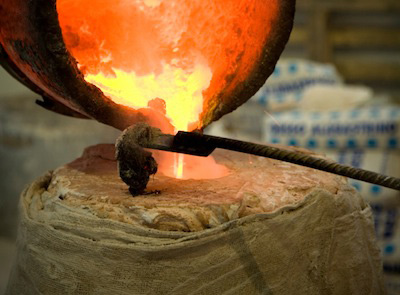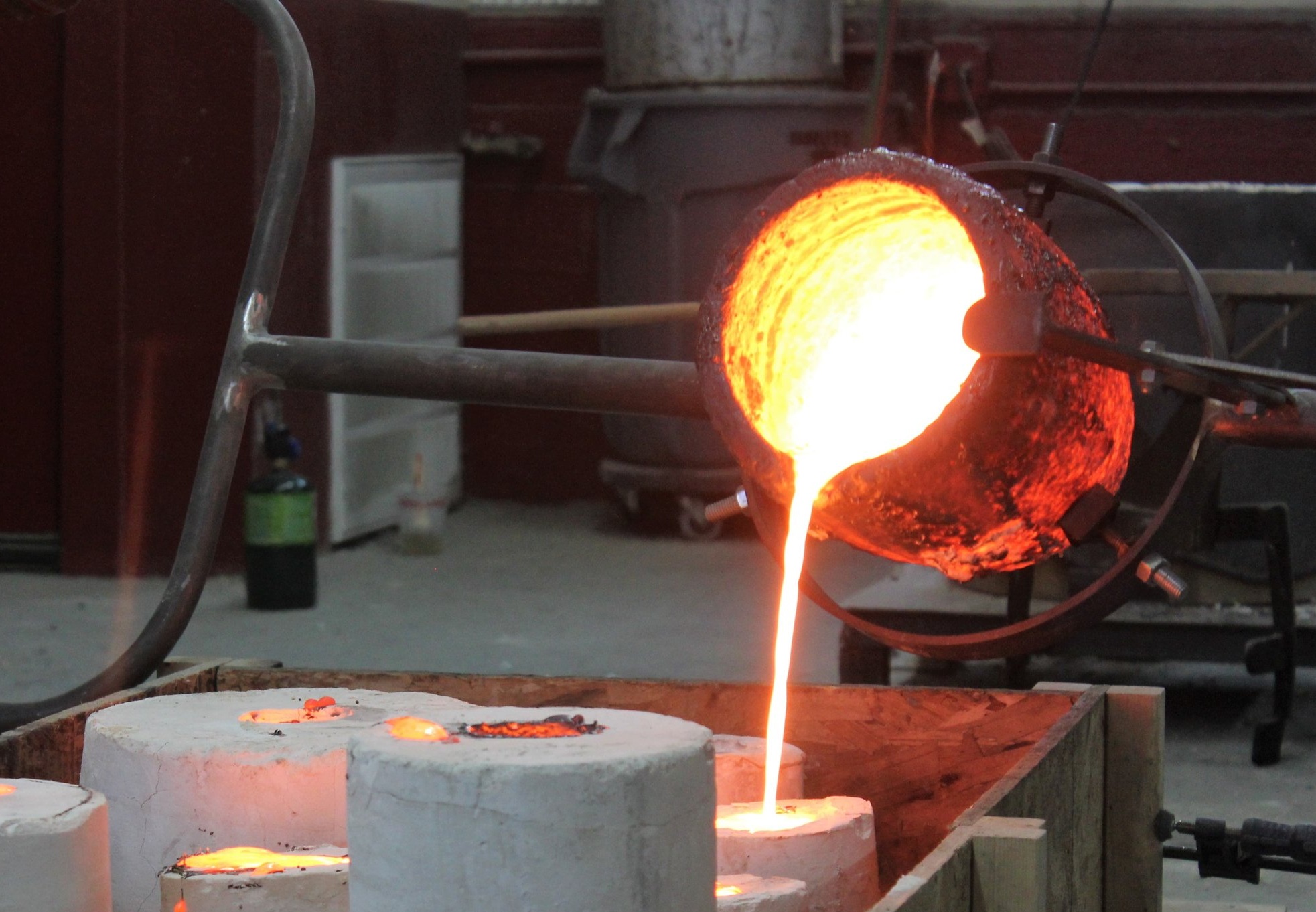Understanding the Steel Castings Process: A Comprehensive Guide for Beginners
The Metal Casting procedure is an essential strategy in producing that transforms molten metal right into strong types. Newbies should comprehend the numerous approaches entailed, such as sand spreading and die casting. Comprehending the materials, design concepts, and safety procedures is equally important. Each facet plays a crucial function in achieving successful outcomes. As one navigates these complexities, the concern of just how to maximize each step for improved results ends up being increasingly important.
The Basics of Steel Casting
Although Metal Casting has actually progressed over centuries, its fundamental concepts remain integral and regular to the production procedure. At its core, Metal Casting involves the makeover of molten metal right into strong objects via numerous methods. The procedure begins with the production of a mold and mildew, which specifies the shape of the end product. As soon as the mold is prepared, steel is heated up to its melting factor and poured right into the cavity. After cooling, the metal strengthens, taking the form of the mold and mildew.
There are numerous casting methods, consisting of sand casting, investment casting, and pass away spreading, each with one-of-a-kind advantages and applications. The selection of technique depends upon factors such as production volume, material type, and wanted accuracy. As soon as cast, the end product might undergo added procedures like machining or surface area treatment to attain the needed finish and specifications. Comprehending these basics is important for anybody thinking about the field of Metal Casting.

Understanding Products Made Use Of in Metal Casting
Materials play an essential function in the Metal Casting procedure, influencing the end product's homes and performance. Various steels are utilized, consisting of light weight aluminum, iron, bronze, and steel, each offering distinctive qualities matched for specific applications. Aluminum is light-weight and corrosion-resistant, making it optimal for auto parts. Iron, especially cast iron, is preferred for its superb wear resistance and longevity. Steel supplies high stamina and adaptability, frequently used in heavy machinery parts. Bronze, understood for its deterioration resistance and machinability, is generally utilized in marine applications.
In addition to the metals, numerous casting products, such as sand, plaster, and ceramic, are used to create mold and mildews. Sand casting, one of the most widespread technique, makes use of silica sand because of its thermal stability and capacity to develop complex shapes. Plaster and ceramic molds offer finer information yet might need more complex processes. The option of materials directly influences the effectiveness, expense, and top quality of the casting operation.
The Style Process: From Principle to Plan
The style process in Metal Casting begins with the initial principle development, where concepts are created and evaluated. This is followed by the application of CAD modeling techniques, allowing for precise visualizations of the style. Lastly, the plan completion steps guarantee that all specifications are properly documented for production.
First Principle Growth
Preliminary idea development notes an essential stage in the Metal Casting procedure, where ideas change into tangible layouts. Throughout this phase, developers work together with engineers and stakeholders to brainstorm and fine-tune preliminary principles. They think about variables such as functionality, looks, and manufacturability, making certain that the style fulfills the required specs and performance standards. Sketches and rough drafts are produced to visualize the ideas, enabling preliminary analyses of feasibility and cost-effectiveness. This phase also includes determining products and potential casting methods that line up with the layout goals. Eventually, preliminary principle development lays the groundwork for a thorough plan, guiding the subsequent phases of the casting procedure and guaranteeing an effective shift from idea to fact.
CAD Modeling Techniques
Changing concepts into precise layouts, CAD modeling techniques play a crucial role in the Metal Casting process. These strategies utilize innovative software application to create comprehensive three-dimensional designs that properly reflect the designated item. By utilizing devices such as parametric modeling, strong modeling, and surface area modeling, developers can manipulate dimensions and forms with convenience. CAD systems additionally help with simulation and analysis, enabling for the recognition of potential problems before production begins. This positive strategy minimizes material waste and maximizes the style for manufacturability. In addition, CAD versions can be quickly changed, enabling fast versions based upon responses. Essentially, CAD modeling offers as the backbone of the style process, bridging the void between initial concepts and the ultimate production-ready styles.
Blueprint Completion Tips
Adhering to the creation of detailed CAD models, the following phase includes blueprint completion, which is critical in translating electronic layouts right into actionable prepare for production. This process starts with reviewing the CAD versions for accuracy and conformity with requirements. As soon as validated, the dimensions, tolerances, and material requirements are thoroughly outlined to ensure quality. Including comments and notes aids connect essential info concerning spreading procedures, surface finishes, and setting up needs. The wrapped up blueprint undertakes an extensive authorization procedure, often entailing partnership with engineers and production groups to deal with any possible concerns. Besides alterations are check out here made and approvals acquired, the plan is officially launched, acting as the fundamental paper for the succeeding phases of Metal Casting, consisting of pattern making and mold layout.
The Metal Casting Strategies Clarified

Metal Casting methods include a range of techniques utilized to shape liquified metal into desired kinds. These strategies vary according to the sort of product, complexity of the layout, and production quantity. Sand casting is one of the most typical approaches, involving the development of a mold and mildew from sand to hold the molten metal. Investment spreading, or lost-wax spreading, enables detailed designs by utilizing a wax pattern that is disappeared. Die casting uses high-pressure injection of molten steel right into a mold and mildew, suitable for mass manufacturing. Various other techniques consist of permanent mold casting, which uses multiple-use mold and mildews, and centrifugal spreading, where rotational forces aid in filling the mold and mildew. Each strategy has its applications and advantages, making it vital for suppliers to select the ideal approach based on their specific demands and needs. Understanding these strategies is important for any individual entailed in the Metal Casting process.
Ending Up Procedures: Enhancing Your Casted Product

Completing procedures play a crucial role in improving the high quality and look see page of casted products. Various surface treatment techniques, such as polishing and finishing, are used to boost durability and aesthetic appeals. Furthermore, top quality evaluation methods ensure that the end product meets defined requirements and efficiency needs.
Surface Therapy Strategies
A range of surface area therapy techniques play a vital function in enhancing the top quality and durability of casted items. These methods consist of approaches such as shot blasting, polishing, and coating. Shot blowing up effectively gets rid of surface flaws, improving the visual and practical characteristics of the casting. Sprucing up offers a smooth surface, which is specifically crucial for ornamental applications and elements needing marginal rubbing. Coating strategies, such as electroplating or powder covering, offer added defense against corrosion and wear, making sure longevity. In addition, surface therapies can boost bond for succeeding processes, such as paint or bonding. By utilizing these approaches, manufacturers can achieve exceptional surface top quality, which is essential for the efficiency and lifespan of Metal Casting in different applications.
Top Quality Inspection Methods
Efficient high quality examination approaches are crucial for assuring the honesty and performance of casted items after the finishing procedures. Numerous techniques are utilized to analyze the quality of Metal Casting, consisting of visual assessment, dimensional checks, and non-destructive screening (NDT) Visual examination enables for the identification of surface defects, while dimensional checks guarantee that products fulfill defined resistances. NDT methods, such as ultrasonic testing and radiographic inspection, provide much deeper insights right into interior honesty without damaging the castings. Additionally, mechanical screening, such as tensile and firmness examinations, reviews product properties - Wisconsin Aluminum Foundry. By utilizing a mix of these techniques, producers can enhance item high quality and dependability, inevitably causing higher customer satisfaction and reduced manufacturing costs
Security Considerations in Metal Casting
While the Metal Casting process uses countless benefits, it also presents a series of safety risks that must be very carefully managed. Employees in casting centers are subjected to high temperatures, liquified metals, and unsafe materials, which can cause severe injuries if proper precautions are not taken. Personal safety equipment (PPE) such as heat-resistant gloves, deal with guards, and safety garments is essential to reduce risks.
Furthermore, the presence of fumes and dirt demands proper ventilation systems to guarantee air high quality - Aluminum Foundry. Regular training on safety and security procedures is essential for all staff members to identify prospective hazards and respond successfully. Emergency situation procedures ought to be established, consisting of fire precaution and first help schedule. Maintenance of tools and correct handling of materials better add to a more secure working environment. By focusing on these security factors to consider, Metal Casting procedures can shield their labor force and maintain reliable manufacturing procedures
Often Asked Concerns
What Are the Ecological Impacts of Metal Casting?
Metal Casting can bring about ecological effects such as air and water contamination, resource depletion, and energy consumption. Additionally, incorrect waste monitoring and discharges from factories add to ecological disturbances and health and wellness dangers for neighboring communities.
How Do I Pick the Right Metal for Casting?
To select the ideal steel for casting, one need to consider elements such as mechanical homes, deterioration resistance, thermal conductivity, and price. Reviewing the intended application and environmental conditions is necessary for ideal selection.
What Are the Common Problems in Metal Casting?
Usual defects wikipedia reference in Metal Casting include porosity, shrinkage, sand addition, and misruns. These concerns typically arise from improper material selection, poor layout, or imperfections in the casting procedure, affecting the last item's quality and performance.
Exactly How Can I Improve My Metal Casting Abilities?
To enhance Metal Casting abilities, one need to exercise constantly, research spreading strategies, evaluate previous jobs for issues, look for feedback from skilled casters, and continuously experiment with different materials and methods to boost efficiency and understanding.
What Is the Cost of Beginning a Metal Casting Business?
Starting a metal casting company commonly calls for a first investment of $5,000 to $50,000, depending on devices, products, and facility prices. Variables like place and scale can considerably influence general start-up expenses.
The Metal Casting process is a fundamental method in making that changes molten steel right into strong kinds. Newbies need to comprehend the different techniques involved, such as sand spreading and pass away spreading. There are several casting techniques, consisting of sand casting, investment spreading, and die casting, each with special advantages and applications. Financial investment spreading, or lost-wax spreading, allows for elaborate styles by utilizing a wax pattern that is thawed away. Other approaches consist of irreversible mold and mildew casting, which uses reusable mold and mildews, and centrifugal casting, where rotational forces aid in loading the mold.